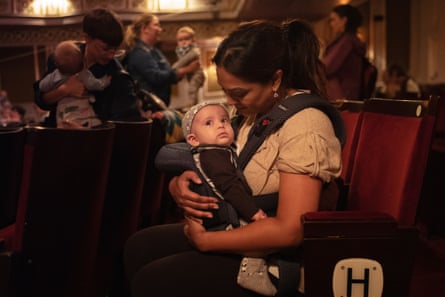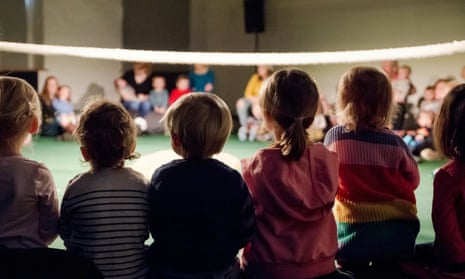It started with the toes. Someone slipped off their shoes at a West End show, propping up their bare feet; their neighbour tweeted a photo in disgust. Joe Douglas, artistic director of Live theatre in Newcastle, popped up to say that he wasn’t bothered. “Our theatre IS your house,” he tweeted. “If your feet smell or the actors are pissed off with your feet being on the stage, we might have words. Otherwise, crack on. #makeyourselfathome”
What does make a theatre feel like home? Negotiating mobile phones, sweet wrappers and chatty Kathys is a well-documented headache for theatre staff and spectators alike. The academic Kirsty Sedgman, in her book The Reasonable Audience, notes: “We may say we want audiences to feel at home in the theatre, but we are still not willing to go so far as to let them act like they are at home.” So can you make everyone feel at home?
Performer and activist Jess Thom found theatres increasingly unwelcoming as her Tourette syndrome developed, and then she was asked to leave the main auditorium during a performance at London’s Tricycle (now Kiln) theatre and spend the rest of the show isolated in the sound booth. “That was such a damaging experience for me,” she says. “I really cried in the sound booth. I felt, that’s it for me and theatre.”
She slowly returned, making acclaimed work including Backstage in Biscuit Land (her Tourette’s means that her conversation is woven with exclamations of “biscuit” and “hedgehog”), and thinking hard about what she needed as both an artist and audience member. Having enjoyed relaxed performances (which aim to be inclusive and accessible, for example in their approach to audience noise and movement) during her longstanding relationship with Battersea Arts Centre in London, she thought: “What if every show takes place in a relaxed environment?”

She explains: “The relaxed performance movement doesn’t name specific impairments. The performances take a relaxed approach to sound and movement from the audience, and consider sensitivities to sound or flashing lights. And they reduce the faff when people arrive at a venue. What is draining for a disabled person is the cumulative effect of all the little things.” Relaxed venues build and maintain relationships with audiences, she says. “You don’t do it with one show, it has to be consistent. Confidence is easier to protect than to rebuild.”
“It’s definitely been a lot of work,” says Tarek Iskander, the artistic director of BAC who has collaborated with Thom to make it the world’s first fully relaxed venue. That’s every space, every show, every single performance. “We expend a lot of energy and resource to exclude people – so why not put that energy into including them?” The stress occasioned by shushing or being shushed, by shame and confrontation – that’s a lot of friction. For Iskander, “just saying that it’s OK to be late, to move around, to make a noise, puts everyone at ease”. Thom mentions meeting a woman whose visit to BAC was her first theatre trip in 15 years, and has also been happily surprised by feedback from non-disabled theatregoers.
Cheery family shows often programme relaxed performances – but, Thom argues, “what is the point in nurturing a love of theatre in children, if there isn’t work for them to see as adults?” Her remarkable performances of Beckett’s daunting monologue Not I were all relaxed. “Most organisations are understandably worried about the impact on artists, but I don’t think we’ve compromised the work in any way,” Iskander says. “The work is better, because it is alive. We’re in a space where anything can happen.”
Time for some test cases. Can you bring your baby to the theatre? Last year, Morgan Lloyd Malcolm, author of Emilia, offered to babysit for someone struggling to see the show, and the producers of this feminist roar of a play followed up with the West End’s first baby-friendly midweek matinee. Bristol Old Vic similarly initiated a series of baby-friendly morning performances.

Few people have tested the theatrical atmosphere more doggedly than Maxine Smiles, who last year set out to visit each of London’s 300-plus theatres (she managed 298), blogging with verve as she went. Capricious box offices, creepy ushers, bewildered punters: they’re all here, at theatres vast and teeny. West End houses should be beacons, she believes, “because that’s often people’s first visit to the theatre, that’s how you get hooked. Yet, because they don’t depend on return trade, they treat their audiences abysmally.” She mentions the Tina Turner musical at the Aldwych, with its prominent signs requesting that punters refrain from singing and dancing. “You walk in and they’re already telling you: no. To a 15-year-old kid making their first visit to a real theatre, that’s extremely off-putting.”
Small fringe theatres with an insider vibe are also problematic, she says. “You’re like, am I allowed to be here?” The warmest welcome? That was at the tiny Pentameters in Hampstead. Leonie Scott-Matthews, who has run the theatre since 1968, “grabs on to you the moment you walk through the door, establishes you’re a newbie and looks after you through the whole thing. On the way out she said, ‘Now you know where we are, you can come again.’”
Of all the city’s theatres, only the Riverside Studios irredeemably squandered her goodwill. “They argued with me about tickets, the ushers were shouting at people,” she shudders. “I will never return.” (William Burdett-Coutts, the artistic director of Riverside Studios, says he regrets Smiles’ experience. “We’ve been doing a lot to try to make the theatre more friendly and accessible,” he says. “We obviously set out to be welcoming, and we try to look after our public.” The theatre, he adds, is even dog-friendly.)
At some venues, a default officiousness inhibits belonging. People of colour often report a visit to the theatre as an unwelcoming thicket of microaggressions (and, occasionally, overt aggression): ignored at the box office, scrutinised by ushers, finding themselves the subject of complaints about everything from big hair to exuberant laughter.
While theatres struggle to rethink their cultures, it’s often left to initiatives such as Tobi Kyeremateng’s Black Ticket Project, which gives cheap or free tickets to young black people, to crack open intimidating spaces. This is a concern for a touring company like Tiata Fahodzi. It is developing a “friendship model” rather than simply promoting individual shows. Artistic director Natalie Ibu believes that “if we get to know our future audiences and engage them in friendship first, then they’ll seek out opportunities to spend more time with us.” The company has appointed a “friendship producer”, tasked with “creating shared moments of connection and relationship with our national African heritage”.
Many venues work hard to get this right – I hear ardent love for the Queens theatre in Hornchurch, the Arc in Stockton, and Slung Low at the Holbeck. To see greeting in action, I spend pre-show time with the welcome team and front-of-house manager Will Bowden at the Young Vic in London. As the first punters arrive, Bowden explains that he hopes everyone will feel “you’ve come into a space that is for you. There’s no airs and graces.” Not only is there no dress code for audiences, there isn’t one for the welcome team, other than a red T-shirt. “Each show brings in a different audience,” says Bowden. The key to policing them, is that “we don’t think of it as policing. It’s still not as relaxed as we’d like it to be, but we don’t stop people from reacting to a show.”
I throw the affable Bowden some challenges. Disruptive mobile phones? “An usher asks you politely not to use it.” Drunken punters? “A difficult one. We try to spot them as they come in and give them a glass of water.” Bag searches? Only at moments of high security alert.
Bowden himself has form as an usher (“Every role I manage I’ve done myself”) and recruits team members through regular workshops: “We’re looking for personalities, with a bit of spark. The ushers feel it’s their home, too – some have been here for 20 years.” I get that when I join the 13-strong team, a red-shirted squad of dauntless enthusiasm. (“They are wild,” Bowden grins. “I can hear them three floors away.”) They go through the seating plan (the configuration changes with every new production) and raise concerns about hearing loops and programmes. As I settle down for the show, I notice them taking time, paying attention, helping a woman with her leg in plaster navigate the space. It’s quiet kindness at work – we should all have that feeling.
“These spaces can be beacons of our community,” says Thom, “sending out messages of love, kindness and welcome. I don’t want anyone to miss out on that.”
This article was amended on 27 February 2020 to remove some personal information.

Comments (…)
Sign in or create your Guardian account to join the discussion